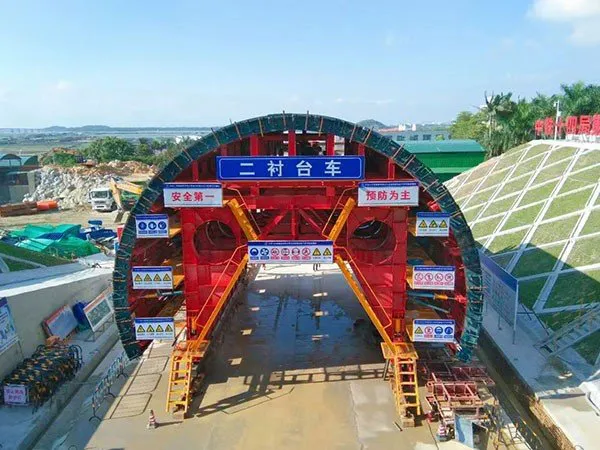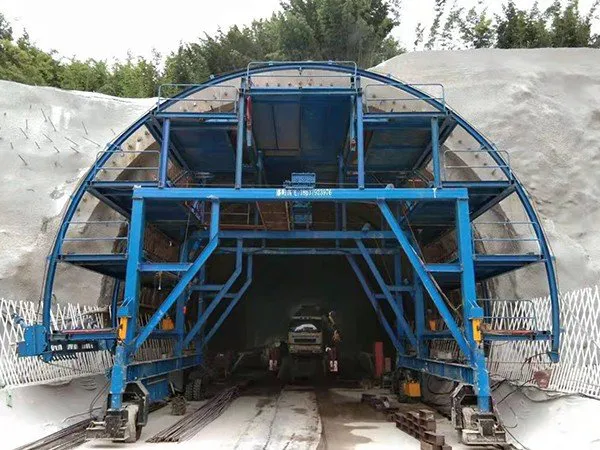Installing a lining trolley in a tunnel project is a complex and crucial process for the secondary lining of the tunnel. It involves careful planning, adherence to safety protocols, and precise execution.

Outside the tunnel (preferred): If space allows, assemble the trolley outside the tunnel portal. This provides a larger, flatter, and more open area for crane operations, facilitating easier assembly and less constrained working conditions.
Inside the tunnel (if necessary): If outdoor space is limited, the trolley can be assembled inside the tunnel. This requires more precise planning and anchor operations due to confined spaces.
Site dimensions: The installation site should be as flat and wide as possible, typically around 20m x 30m. If installing inside the tunnel, ensure at least 50 cm clearance above the trolley and 30 cm on the sides. The length of the obstacle-free area should be at least twice the length of the trolley plus 3 meters for lifting operations.
The ground must be leveled and compacted to create a stable base for the tracks.
Lay the tracks according to the specific gauge requirements of the lining trolley.
Ensure the tracks are straight, free of triangular pits, and have no staggered seams.
Maintain a height difference of less than 5 mm between the front, rear, left, and right rails.
Align the track centerline as closely as possible with the tunnel centerline (error less than 15 mm).
Track sleepers should be spaced generally at 0.5 meters or less and securely nailed.
Use heavy steel rails (e.g., 38kg/m).
Conduct a thorough inspection of all lining trolley components for any damage, wear, or malfunction.
Ensure all personnel are trained in safety procedures and equipped with appropriate PPE (helmets, gloves, safety harnesses).
Establish clear communication protocols and designated safety zones.

Use a lifting device (crane or chain block) to place the driving and driven wheel frames onto the laid tracks.
Provide temporary support and adjust the distance between the front and rear wheel frames according to the centerline of the bottom longitudinal beam.
Lift the bottom longitudinal beam above the installed wheel frames.
Use bolts for temporary support and check that the diagonal measurement is within the correct value.
Generally, portal frame sections are first assembled on the ground.
Then, they are hoisted one by one to their respective positions on the bottom longitudinal beams and temporarily secured with bolts.
Once the portal frames are in place, install the lock beams and scissor braces in each bay.
Adjust and align them using a vertical plumb bob or by eye.
Tighten all bolts promptly to form a complete and stable skeleton.
Install the jacking cylinders and any other specified components of the hydraulic system that facilitate the trolley's movement and formwork adjustment.
Lift the Lifting Beam and Install the Platform Beam:
First, lift the platform beam onto the top of the jacking shaft cylinder.
Adjust the center distance and diagonal.
Add temporary support, then lift the lifting beam onto the top of the platform beam and fasten it with bolts.
When installing the top formwork, begin from the middle and work outwards to minimize accumulated errors.
Install the first top formwork in the middle, then check that the chord length and height meet design standards before installing the remaining top formwork.
To ensure the trolley's stability, thoroughly check and tighten all diagonal braces and supports on the suspension beam.
After inspecting the top formwork, install the side formwork.
Install symmetrically to prevent tilting.
If installing inside the tunnel, transport the side formwork into the tunnel first and place it near the side wall for easier hoisting.
Adjust the side formwork to ensure a smooth, flat surface with no misalignment at the joints and that geometric dimensions meet design requirements.
Finally, install any through beams and the overall support system for the tunnel lining trolley.

Use appropriate lifting and rigging techniques to safely hoist and maneuver the lining trolley into its operational position.
Attach lifting slings or cables securely to designated lifting points, ensuring even load distribution to prevent tipping.
Coordinate with crane operators for smooth and precise lifting.
Once in position, carefully align the trolley with the designated lining area using manual or mechanical adjustment mechanisms.
Utilize leveling devices, laser alignment tools, or visual cues to ensure accurate and secure positioning on the tracks. The centerline of the formwork must coincide with the tunnel centerline.
Engage locking mechanisms, brake systems, or safety pins to prevent unintended movement.
Double-check all connections, fasteners, and locking devices to ensure they are properly engaged.
Conduct a final inspection to verify correct positioning, alignment, and security.
Perform functional tests and load tests (if applicable) to validate the trolley's stability, functionality, and safety.
Remove any debris, tools, or equipment from the work area and ensure it is clear of obstacles.
Types: There are various types, including simple, fully hydraulic automatic, walking lining trolleys, and grid-type trolleys. The choice depends on project requirements, tunnel section dimensions, and construction methodology.
Design: The trolley design must meet the external dimensions of the tunnel section, ensure accurate formwork alignment, and allow for efficient mold supporting, dismantling, and locking.
Hydraulic System: Modern trolleys often use hydraulic systems for formwork support, demolding, and movement.
Mobility: Trolleys can be wheel-rail type (requiring track laying) or self-propelled (hydraulic drive).
Safety: Always prioritize safety. Ensure proper training, use of PPE, clear communication, and adherence to all safety regulations.
By following these comprehensive steps and maintaining strict safety protocols, a tunnel lining trolley can be successfully installed and commissioned for efficient tunnel lining operations.
Gaofei
Address: 200m east of tulip garden, group 12 of zhangling community, hongshan street office, hongshan town, xigong district, Luoyang
Tel: +8616638856888
Contact: Gaofei Huang
Mobile: +86-18637923976
Phone: 0379-80881719/ 0379-60162687
QQ: 286827457
E-mail: gaofei@gf-bridge-tunnel.com